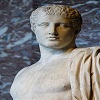Achelous
the god of the river Achelous who was the greatest and the oldest river of Ancient Greece
In Greek mythology, Achelous was a river god. He was the son of Oceanus and Tethys and the eldest of 3,000 brothers. His union with one of the Muses produced the Sirens, alternatively known as the Acheloiades ("daughters of Achelous"). His name means "he who washes away care."
The Achelous River is the largest natural fresh waterway in Greece. It rises on Mount Pindus and flows in a southerly direction, forming the boundary between Acarnania and Aetolia. Finally, it flows into the Ionian Sea opposite the Echinades islands.
he Achelous River is about 130 miles (210 km) in length. It is said to have been formed by the tears of Niobe, who fled to Mount Sipylon after the deaths of her husband, Amphion, and her six or seven children.
From the earliest times Achelous was worshiped throughout Greece as a great river god. He was honored with sacrifices and invoked in prayers. Achelous was the personification of, and a byword for, all freshwater.
Roman poet Virgil (70-19 BCE) used the term Acheloia pocula ("cups of Achelous") to refer to water in general.
The story of a wrestling match between Achelous and Heracles over the latter's bride, Deianeira, is often depicted in ancient art.
Achelous was initially overpowered by Heracles, but the river god turned himself into a raging bull. Heracles then broke off one of his horns with a great show of force.
Achelous later recovered this horn from Heracles by giving him in return the horn of Amaltheia, the Greek equivalent of the cornucopia (horn of plenty).
According to Roman poet Ovid (43 BCE-17 CE), in a somewhat different version, the Naiads received the horn that Heracles took from Achelous and changed it into the horn of plenty.
Achelous in art
In Greek art Achelous is depicted with the lower body and horns of a bull, and the face and torso of a man. He appears frequently in Greek vase painting, where he is shown wrestling with Heracles.
He is also found in Greek sculpture, especially in the so-called nymph reliefs - the small carvings dedicated to the water goddesses and the god Pan. These effigies usually show the nymphs dancing in a line in a cave.
In most cases only the bearded face of Achelous with his horns is shown at the side of the scene. Achelous also appears in Roman mosaics, although far less frequently than in Greek art.
[1]












